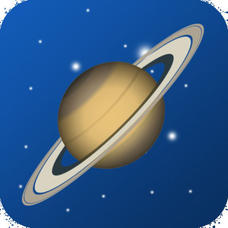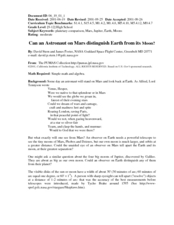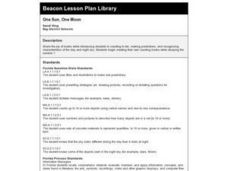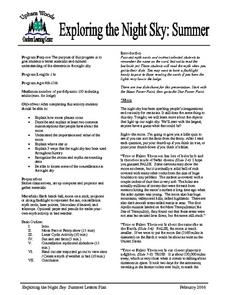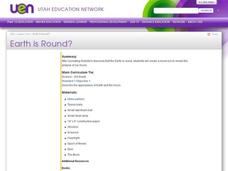Q Continuum
Planets
Have you ever looked up at the night sky and wondered what constellation you were seeing or whether that bright object was a star or a planet? Are you searching for the best tilt-to-view constellation and planet app that money can't buy?...
Curated OER
Can an Astronaut on Mars Distinguish Earth from its Moon?
High schoolers explore the possibility of being on Mars and being able to identify the Earth. In this space lesson plan students complete a set of calculations to see if this is possible.
Curated OER
The Earth, Sun, Moon, And Stars
Fifth graders explore the solar system. In this solar system unit, 5th graders investigate numerous projects while rotating through learning centers. Students write about space and construct a space shuttle model. Students practice map...
American Museum of Natural History
Planetary Mysteries
A website all about planetary mysteries—it's a one-stop-shop for all things, stars, planets, and space travel. Scholars read an astronomy overview to discover the page's big ideas, then choose from the plethora of resources, including...
Curated OER
Night Sky
Students discover why stars can only be seen at night. They participate in a read aloud of, "Night Sky" by Carole Stott and, "Switch on the Night" by Ray Bradbury. Using the sky objects described in the readings, they brainstorm and list...
Curated OER
What's Up?
Students compare and contrast the various heavenly bodies found in the sky at night. They identify the moon and stars in the sky as well as how the stars form pictures called constellations. Students also experiment with reflection and...
Curated OER
Ban Ki-moon
In this famous person worksheet, students read a passage about Ban Ki-Moon and then complete a variety of in-class and homework activities to support comprehension, including partner interviews, spelling, cloze, synonym matches, and...
Curated OER
Exploring the Night Sky: Fall/Winter
Students explain how moon phases occur. They explain three ways that the night sky has been used through history. Students locate some of the constellations in the night sky. They discuss stories and myths surrounding stars.
Curated OER
Heavens Above
Students study the stars and their positions. For this astronomy lesson students see how scientists can predict the positions of the stars and can tell how they would have appeared in the past.
Curated OER
One Sun, One Moon
First graders read "Ten Black Dots" by Donald Crews and then create their own counting books focusing on the number 1 (one) and using yellow dots to represent the sun, moon and stars.
Curated OER
Moon Journal
Fourth graders observe Moon and its features, and record results both in written form and in a drawing on the given template.
Curated OER
Number the Stars The Swastika
In this Language Arts worksheet, students read a quote from Number the Stars about a swastika. Students also read a history of how the swastika was once a symbol of peace.
Curated OER
Exploring the Night Sky: Summer
Students explain how moon phases occur. They describe and explain at least two common misconceptions that people have about the moon. Students explain what a star is. They explain 3 ways that the night sky has been used throughout history.
Curated OER
Earth is Round?
Third graders discuss how Aristotle concluded that the Earth was round. As a class, they review theories about the Earth's shape and describe how life on Earth would be different if it were flat. Individually, they make a moon book in...
Curated OER
Sky Observation Project
In this sky observation worksheet, learners make observations of the night sky and use their planisphere and star charts to help identify what they observe. They make observations and record what they see for 10-15 minutes. They draw a...
American Museum of Natural History
What is Astronomy?
Go study the universe. Pupils learn seven aspects about astronomy and astronomers. They begin to learn about constellations; distance and motion between objects; gravity; the electromagnetic spectrum; dark matter and energy; and teams of...
PBS
Star Power
Let there be light—or maybe not. Pupils learn about light pollution with an investigation of constellations. They create constellation boxes and experiment with different levels of light. Observations are then made about the lighting in...
Curated OER
The North (Wall) Star
Students engage in a instructional activity which shows them that celestial navigation is the art and science of finding one's geographic position by means of astronomical observations, particularly by measuring altitudes of celestial...
Curated OER
Why do Stars Rise in the East?
In this stars rise in the east worksheet, students use geometry to show how the Earth rotates from west to east and why celestial bodies appear to rise in the east and set in the west. Students draw a figure and label given points in...
Curated OER
Reading and Writing About the Solar System
Utilizing the classic Magic School Bus series, young scientists explore the solar system. Some excellent worksheets are included in this plan, such as Planet Roll Call and Solar System in Motion. This is an ambitious 5-day unit that...
Curated OER
How Big Are Earth, Sun, and Moon?
Third graders draw what they believe is in space on a dry erase board. In groups, they are given a beaker half filled with water and they add a teaspoon of oil, observing the different layers that form. To end the lesson, they identify...
Curated OER
Star Stories
Students study constellations and the stories that go with them. They identify at least 3 constellations in the night sky. Students recognize some of the myths surrounding the constellations. They create their own constellation and myth.
Curated OER
Moons
Students practice rote counting to 20. After a lecture about the planets and the moons that surround them, they identify the number of moons surrounding various planets. Students compare and contrast the quantity of moons surrounding...
Curated OER
The Appearance of the Moon
Third graders watch a demonstration on how craters were formed on the moon. Individually, they care given a set of materials that represent the moon surface and make their own craters. To end the activity, they measure the size of the...
Other popular searches
- Sun Moon Stars
- Sun Moon and Stars
- Sun, Moon, Stars
- Sun, Moon and Stars
- Sun Moon and Stars Activity
- Earth Moon and Stars
- Stars and Moon
- Identifying Sun Moon Stars
- Observing Moon and Stars
- Sun, Moon, and Stars
- Earth, Moon and Stars


